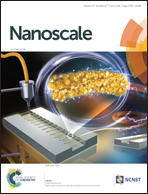Buckminsterfullerene hybridized zinc oxide tetrapods: defects and charge transfer induced optical and electrical response†
Abstract
Buckminster fullerene (C60) based hybrid metal oxide materials are receiving considerable attention because of their excellent fundamental and applied aspects, like semiconducting, electron transfer, luminescent behaviors, etc. and this work briefly discusses the successful fabrication of C60 decorated ZnO tetrapod materials and their detailed structure–property relationships including device sensing applications. The electron microscopy investigations indicate that a quite dense surface coverage of ZnO tetrapods with C60 clusters is achieved. The spectroscopy studies confirmed the identification of the C60 vibrational modes and the C60 induced changes in the absorption and luminescence properties of the ZnO tetrapods. An increased C60 concentration on ZnO results in steeper ZnO bandgap absorption followed by well-defined free exciton and 3.31 eV line emissions. As expected, higher amounts of C60 increase the intensity of C60-related visible absorption bands. Pumping the samples with photons with an energy corresponding to these absorption band maxima leads to additional emission from ZnO showing an effective charge transfer phenomenon from C60 to the ZnO host. The density of states model obtained from DFT studies for pure and C60 coated ZnO surfaces confirms the experimental observations. The fabricated C60–ZnO hybrid tetrapod based micro- and nanodevices showed interesting ethanol gas sensing characteristics.



 Please wait while we load your content...
Please wait while we load your content...